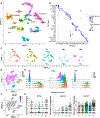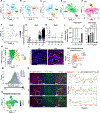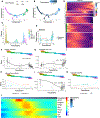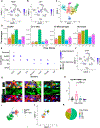Temporal analyses of postnatal liver development and maturation by single-cell transcriptomics
- PMID: 35134346
- PMCID: PMC8842999
- DOI: 10.1016/j.devcel.2022.01.004
Temporal analyses of postnatal liver development and maturation by single-cell transcriptomics
Abstract
The postnatal development and maturation of the liver, the major metabolic organ, are inadequately understood. We have analyzed 52,834 single-cell transcriptomes and identified 31 cell types or states in mouse livers at postnatal days 1, 3, 7, 21, and 56. We observe unexpectedly high levels of hepatocyte heterogeneity in the developing liver and the progressive construction of the zonated metabolic functions from pericentral to periportal hepatocytes, which is orchestrated with the development of sinusoid endothelial, stellate, and Kupffer cells. Trajectory and gene regulatory analyses capture 36 transcription factors, including a circadian regulator, Bhlhe40, in programming liver development. Remarkably, we identified a special group of macrophages enriched at day 7 with a hybrid phenotype of macrophages and endothelial cells, which may regulate sinusoidal construction and Treg-cell function. This study provides a comprehensive atlas that covers all hepatic cell types and is instrumental for further dissection of liver development, metabolism, and disease.
Keywords: construction of metabolic zones; endothelial cells; functional maturation of liver; hepatocyte heterogeneity; interaction of macrophages; postnatal liver development; single cell transcriptomics.
Copyright © 2022 Elsevier Inc. All rights reserved.
Conflict of interest statement
Declaration of interests The authors declare no competing interests.
Figures







References
-
- Alvarez M, Rahmani E, Jew B, Garske KM, Miao Z, Benhammou JN, Ye CJ, Pisegna JR, Pietiläinen KH, Halperin E, and Pajukanta P (2020). Enhancing droplet-based singlenucleus RNA-seq resolution using the semi-supervised machine learning classifier DIEM. Sci Rep 10, 11019. 10.1038/s41598-020-67513-5. - DOI - PMC - PubMed
Publication types
MeSH terms
Substances
Grants and funding
LinkOut - more resources
Full Text Sources
Other Literature Sources
Molecular Biology Databases

